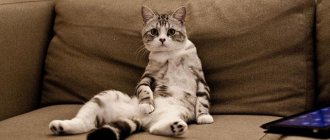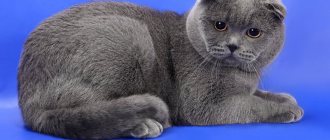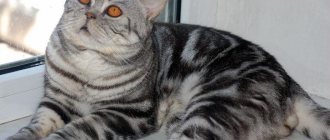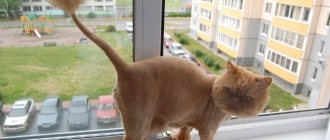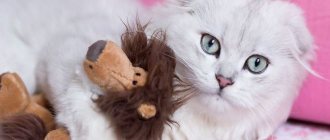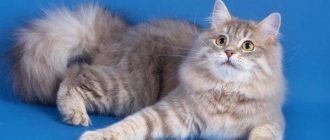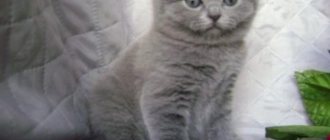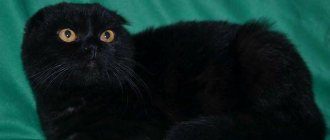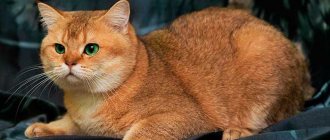The Scotch is an intelligent, moderately active cat who enjoys teasing toys, but her favorite pastime is anything that involves human interaction. The Scottish cat likes most to be in contact with its owner and take part in everything that he does. These are pets that love attention.
When talking about the Scottish cat breed, they most often mean the fold-eared version, or Scottish fold. Although in fact there are 4 varieties. But since lop-ears are the main one, the history of the occurrence of this interesting mutation began with them.
History of the breed
Scotland is considered the homeland of the Scottish, from where they quickly come to America, and then continue their march in Europe. It was American breeders who did a lot of work to secure the hanging ears. Their stud books contain all kinds of data for each representative of the breed: from nicknames to names of owners.
Numerous studies have been conducted not only on the physiology of cats, but on the genetic diseases that this ear shape brings with it.
The very first mention of the only fold-eared cat brought from China dates back to the 18th century. What happened to her later is not known for certain. Another mention of this country dates back to 1796, where a magazine describes a kitten with funny drooping ears.
The first mention in Scotland dates back to 1959, when one of the farmers saw an interesting animal among his neighbors. This was the ancestor of the whole breed - Susie, born from completely unpresentable yard cats. The white short-haired Snooks, obtained from her in 1961, becomes the next successor to the family, since the mother dies. And it is the date of her birth that is considered the beginning of breeding Scottish Fold cats.
It should be remembered that every Scottish Fold in the world is a brother or sister to another representative of the breed, since they appeared thanks to a single cat. This is why it is so important to choose the right pairs for the birth of kittens. This will help avoid further unwanted mutations, genetic pathologies and non-viable offspring.
Having received several kittens from Snooks, the Ross couple, who had previously been breeding Siamese cats, registered the Denisla cattery and began serious breeding work. They turn to geneticists to create a program to preserve the unique shape of the auricle. British cats were used in breeding, which is why these two breeds are so similar. Very little time passes and the breed is officially recognized by the English Cat Fanciers Association.
The year 1971 was marked by a ban on breeding work with these beautiful creatures. The first reason was the excessively large number of kittens born with heterochromia (white color and blue eyes), which causes deafness.
The second reason had physiological characteristics - due to the shape of the ears of representatives of the breed, it was quite difficult to cure otitis media in cats, remove ear mites, and in general, hygienic cleaning of the auricle was difficult.
Despite the fact that both problems were soon eliminated, the English Club has not recognized the breed to this day. Although a number of nurseries continue to exist and conduct breeding work in the country.
Another problem faced by Scottish breeders is the sublethal Fd gene, which is responsible for the necessary shape of the ear. As long as matings were made within the breed (low-eared and straight-eared) or the blood of other breeds was infused, the gene did not often produce side effects. But as soon as the standard was officially recognized, matings with other representatives of the breeds were stopped.
In addition, Scottish Folds began to be exported to other countries, where they tried to fix the density of the ear, which means that matings with Scots, who were born with erect ears, practically stopped. The birth of kittens began with serious anomalies of the skeletal system, which led to deformity: spinal defects, fused spinal discs, shortening of the bone, pathologies of cartilage tissue, etc. Which led to a ban on breeding Scottish cats in many countries.
Fortunately, everything turned out to be not so scary and geneticists were able to study ways of transmitting this gene. Certain rules were drawn up for breeders, which became a kind of unbreakable dogma in the Scottish cat breeding program.
The most important rule is that mating between two representatives possessing the folding gene is strictly prohibited!
But since kittens of both types (stride and fold) continue to be born in litters, this rule is quite easy to follow. The difference between these two types is only in the shape of the auricle. The Straight (a Scotsman with erect ears) has all the character traits and exterior features of the Fold (a fold-eared variety of Scottish cats).
Most often, 1-2 Fold kittens are born in a litter. But from the first day it is impossible to determine the exact number. Another characteristic feature of the Scots is that the ears begin to droop and curl only on the 21st day. Only after this can you confidently attribute each kitten to its own variety of Scots.
Scottish cat with erect ears
The ability to knit strides and folds with each other significantly affected the further history of the Scots. It is thanks to pointy-eared cats that the phenotype of the breed can be preserved.
Although single matings with British cats do occur, they are still undesirable, since the breeds differ in many ways. And they are allowed only if it is necessary to inject fresh blood and only for those animals in whose pedigree there are several generations of matings between folds.
Not every breeder can consciously agree to such conditions - too large a percentage of kittens are discarded due to anomalies. In addition, regular matings between the Scots and the British can lead to unstable hanging ears, which is a breeding marriage, and in appearance such kittens begin to look more like British cats.
That is why straights are indispensable in the breeding program of every breeder. Unfortunately, this in-breed type can only be used by breeders and as pets, since they are not allowed to participate in international exhibitions.
Despite their great popularity in the world and at home, American nurseries continue to be considered the best. It was there that simply titanic work was carried out to identify all the possible consequences of mating two homozygous Scots. It is on these results that the work of breeders in many countries is based, where it is considered a great success to get a breeding Fold cat from the USA.
Currently, this breed is recognized only by the WCF (World Cat Federation). The second no less large international Federation International Feline (FIFe) continues to ignore the popularity of folds, considering the appearance of a pathology and culling all the kittens that appear.
Intraspecific types:
- Scottish fold or fold cat. The most popular variety of Scots. Tightly fitting floppy ears, large wide eyes of a curious child, round head, soft plush fur - you want to pick her up and not let go.
- Scottish straight or straight-eared cat. Slightly smaller than Scottish and with erect ears - that’s all the difference between these two varieties.
- Highland fold or longhaired fold. A very beautiful and graceful animal. A rounded head, a strong chin, a high forehead, a powerful neck, a compact body - this cat immediately sets you up to be taken seriously. Everything is “spoilt” by wide open eyes with a curious expression and a visual absence of ears (the long hair almost completely hides them). It should be remembered that there is no longer decorative hair on the shoulders and around the neck. The hair in these places, as well as on the paws and face, is shorter.
- Highland stride or straight-eared cat with long hair. Perhaps the rarest representative of the Scottish breed. The soft, long, flowing coat is reminiscent of the hair of Angora and Persian cats, but is silkier and denser to the touch.
Review of the Scottish Straight breed: straight-eared Scots are back in fashion
In this article we will look at one of the youngest recognized breeds - the Scottish Straight. Translated, the name of the breed means “Scottish straight-eared” cat. Scottish Straight kittens can also be born to a fold-eared cat, since the second parent must be straight-eared.
In general, four types of cats belong to the Scottish breeds:
- Scottish Straight Shorthair (Scottish Straight); Scottish Straight Longhair (Highland Straight); Scottish Fold Shorthair (Scottish Fold); Scottish Fold Longhair (Highland Fold).
In some felinological associations, all these varieties are approved as one breed, in others they are divided into two main ones - straight (straight ears) and fold (low-eared).
And if the difference in the length of the fur is visible almost immediately, then the shape of the ears is finally formed by the end of the first month of the kitten’s life.
Scottish fold
The Scottish Fold, or short-haired, fold-eared Scottish cat, is distinguished by its inimitable baby face due to the fact that its muzzle is round, its eyes are round and large, its ears bend around its head, which creates the illusion that it is spherical. To this advantage it is worth adding short hair with a very dense undercoat, as a result of which such murkies look like teddy bears.
Another undoubted advantage of the Scottish fold is its character. Soft, friendly, affectionate, accommodating, not aggressive. True, it is worth noting that many individuals are very restive and have character. This largely depends on the presence of British genes within 4-5 generations: if these genes are present, then the character may be more rigid.
It is not surprising that such cats, despite the very complex history of the breed, eventually conquered the whole world and are the pets of many people, even celebrities, who have access to any expensive animals, even tigers and lions.
In general, the Scottish Fold cat is a real dream. With one exception: the lop ear gene in some cases leads to joint diseases. We won’t talk about this in detail now; you will read about the lop-eared gene in a separate article. Let's just say that every future owner should know about this feature. Read more about the Scottish fold here.
Origin story
The ancestor of Scottish cats is considered to be a cat named Susie, who was born in 1961 and was a carrier of the mutation gene (FdFd), which is why her ears were folded. It was with this cat that work began on the Scottish Fold breed. Breeders sought to consolidate fold ears in their descendants, and to give the breed a pretty appearance, crossbreeding was carried out with other breeds: Persian, Burmese, American Shorthair and British. As a result, the breed developed a rounded head, large round eyes, and lop ears.
Breeders have noticed that if Scottish Folds are crossed with each other, this leads to congenital malformations of kittens (problems with the spine). Then it was decided to cross Folds only with Straights, in order to avoid the harmful effects of the mutation gene for folded ears.
In a litter of Scottish cats, both fold-eared and straight-eared kittens were born, approximately equally, and mainly fold-eared kittens were developed and exhibited. In the 21st century, they decided to eliminate this injustice and recognized the straight-eared Scots as a separate breed with the right to an exhibition career. Straight-eared Scots are no different from folds, with the exception of the shape of the ears and the presence of mutation genes.
Health and care
Scottish cats, in addition to their character, delight owners with their unpretentiousness and endurance.
This breed requires minimal care to stay healthy and happy.
Care
- approximately one bath per month with a special shampoo;
- trimming nails as needed (usually once a month);
- combing along the entire length, especially on the neck, paws and belly. For short-haired dogs - a natural comb with frequent small teeth, for long-haired ones - with sparse and long teeth;
- cleaning the ears with a cotton swab once a month before washing;
- wipe the eyes with a damp swab;
- the insidious plush fur does not dissolve well in the kitten’s stomach, so from the age of six months it must be accustomed to a special paste to safely dissolve and remove the fur from the body.
We invite you to find out which cat breed is the kindest and most affectionate.
Why does a cat sleep so much? How long should a cat sleep? Read in this article.
Health
Scots are a breed that rarely gets sick. Straights did not have “their own” diseases, but folds , due to heredity, may develop hemophilia - increased bleeding .
You also need to remember the danger of anomalies and death when crossing with a similar breed. Scottish folds can only with straights.
Both breeds also need to periodically check their teeth and ears for infections or unnecessary deposits.
What to feed
- Scottish kittens up to three months must be fed 6-7 times a day with 150 grams of formula; later it is better to limit dairy products - they can cause stomach upset;
- six-month-old kittens eat 250 grams 4 times a day, consisting of boiled meat, vegetables, liver and cereals; at this age, the kitten should not be given raw meat or fish;
- Older cats eat 2-3 times a day; their diet should consist of 60% meat thawed at room temperature, 30% vegetables and 10% cereal. The diet should include vitamin complexes, eggs, offal and dairy products.
It is forbidden:
- Feed your cat only dry food - this negatively affects the health of the stomach and can lead to irreversible consequences;
- giving your pet food from the owners’ table - it may turn out to be harmful, and it is very difficult to wean it off begging;
- Feeding expired food is very dangerous for your health!
- give your cat bones and too hard food;
- you need to monitor your Scottish cat's calcium intake, especially the fold cat's - an overabundance of the mineral may cause her ears to become erect.
Scottish Straight Standard
The Scottish Straight cat became an independent breed from the Scottish Fold breed, and was officially recognized by the International Cat Fancier Association (CFA) in 2004.
Scottish cats come in long-haired and short-haired varieties, and come in a variety of colors, patterns, and shades. It can be plain, ticked, patterned or spotted.
The main difference between Scots and British cats is the clearly defined shape of the head, proportional legs, and pointed ears. The British are naturally more massive, with characteristic cheeks on the face, rounded ears and the tip of the tail.
- Body: medium size, proportional, well-developed muscles. The body shape is round. Massive body size is considered a disadvantage. The weight of the animal is within 6 kg. Cats are bigger than cats. Head: round, voluminous. The chin is pronounced. Cheeks are full. The nose is straight, wide, short. There is no stop. The head smoothly transitions into a wide and short neck. Ears: straight, widely spaced, full size. The shape and fit of the ears favorably highlight the roundness of the head.
Important! If a Scottish Straight has small ears, then it is quite possible that it is a Scottish Fold with straightened ears. This fact is very important if you are adopting a kitten for further development of the breed.
Description of the breed (appearance) of the Scottish cat
Scottish cats have a certain set of characteristics that distinguish them from other breeds. Their closest relative is the British species, however, it is characterized by a more rounded head shape. Scots have a beautiful, graceful body that is quite small in size compared to other domestic cats. Its weight is correspondingly also small: from 3 to 5 kg. The difference depends on gender. As expected, males are larger.
The movements of these animals are very flexible due to their slender, flexible body. Interestingly, no matter what age your pet is, he will always remain playful and resilient. This breed differs significantly from the classic varieties. Due to their special external characteristics, owners often give preference to the Scots. The moment of purchasing an animal is very important, because breeders often deceive future owners by selling them a British cat instead of a Scottish one.
The fact is that the latter are distinguished by their inflexible character, and when people purchase an animal, they are afraid of buying the wrong kitten. Thus, if you decide to have a little Scotsman at home, find a reliable breeder and show maximum care when making a purchase. To reduce the risk of a possible mistake, you need to know the main distinguishing features of the Scottish breed.
These include, in particular, the following:
- Pronounced rounded head shape;
Smoothly merging into the neck;
Large and expressive round eyes, clearly visible on the face;
Wide, oblong nose;
Ears rounded upward;
The tail is quite wide, gradually narrowing;
The coat is short, smooth, pleasant to the touch.
And there are also long-haired varieties of this breed.
Behavior: character of Scottish cats and cats
The Scots are distinguished by their good disposition, developed mental abilities and, accordingly, high learning ability. They are characterized by modest, unobtrusive behavior, although, as with any rule, there are also exceptions - there are very stubborn and persistent representatives of this breed. And yet they do not need special attention.
To please your pet, you just need to give him just a minute of attention, pet him or scratch him behind the ear. If you are a supporter of home gatherings with guests, then you don’t have to worry that your pet will react aggressively to strangers. The Scots, unlike the British breed, are distinguished by their calm, balanced character.
These cats know how to be truly loyal, becoming attached to their owner and showing him their love and goodwill. In relation to other family members, the pet may not show any attention at all. It is not recommended to forcibly pick up a cat; any cat, regardless of breed, will not like this; Scots are no exception. Kittens quickly adapt to new conditions and also quickly become attached to their owner.
In relationships with other animals, these cats behave calmly and easily find a common language with them. You need to get a pet when you are still a small kitten, so that you have the opportunity to train and raise it yourself. Otherwise, it will not be possible to re-educate the pet. Many people like this breed because the kittens are very obedient. In order for the kitten to understand the owner’s attitude towards him at the moment, just one intonation is enough. Little Scots quickly get used to the tray.
And they are also very good at distinguishing between those things that are prohibited from doing, what is allowed or encouraged. Despite their calm disposition, it cannot be said that these cats lead an inactive lifestyle. This breed is characterized by playfulness and curiosity, but compared to their close relatives - the British - these qualities are moderately developed.
How to breed Scottish cats
During the first mating, you need to breed Scots only when the cat reaches sexual maturity, that is, one and a half years. Many beginners make a serious mistake when, observing the first signs of readiness for breeding - and this is approximately 9-10 months - they allow the first mating. This is fraught with negative consequences for the cat’s health; in addition, kittens that are still born can die in the womb or immediately after birth, be born with pathologies, etc.
When the cat reaches one and a half years old, the owner must determine the moment of estrus and find a partner for his pet. You need to take care of this in advance, since it is not so easy to find a truly good partner, and cats of this breed only go into heat for 4–6 days. As for cats, at the end of puberty they are completely ready for mating. From this moment on, breeding can be done at any time, and this will not entail any diseases or other negative consequences either for the animal itself or for its offspring.
Scots colors
Plain (solid)
The coat color is uniform, without interspersing any other color. Any spots or stripes are considered a defect in a solid color.
white; black (ebony); red (deep red); blue (blue) - kittens with such gray fur most resemble a British shorthair cat; chocolate (dark brown) – a rather rare color for Scots; lilac (lavender) – a cool shade of fur, without redness; cream – warm beige color, paws and nose match the shade of the coat; fawn (light beige) – the color of the fur of a young fawn; cats of this color have soft pink paw pads and nose; cinnamon is a warm, light shade of brown, the paw pads and nose are always pink.
Bicolors (two-color)
The main color is white, it makes up from 1/2 to 1/3 of the entire body. The second color is any of the solid ones. Cats with a symmetrical pattern and color distribution are valued higher.
The most popular bicolor colors among Scottish Straights are:
Color point
Color point cats have a light body and dark face, ears and paws. The gene responsible for color is linked to blue eye color.
Blue point - blue spots. Lilac point – lilac shades. Seal point is a Siamese with black markings. Choklit point - chocolate markings. Red point - red shades.
Tortoiseshells
Tortoiseshell color is usually red, black and white spots unevenly distributed on the main color of the coat, which, under the influence of the genes of the parents, can take on blue, cream, chocolate and red shades. Tortoiseshell colors are conventionally divided into 3 types:
Calico is a patchwork color, spots of different colors are quite large in size. Torti is a random distribution of small black and tan spots throughout the body. Tortoiseshell with white – distribution of black, red and white spots.
Smoky
With the smoky color, Scots have a silver gene, which colors a small part of all hairs. Wool takes on beautiful combinations of light and dark shades. The most popular color among Scottish Straights is black smoke, however, smoky pets are not favorites at shows.
Tabby
The most popular color among the Scots. The pattern is divided into 3 types: tiger stripes, spots and marble. There are a wide variety of color combinations: golden tabby, black marble, marble on silver, cameo.
Chinchilla
The color came to the Scots from the British. Maintaining the color is quite difficult since both parents must be chinchillas. Color is divided into 3 types:
- Golden chinchilla . Silver chinchilla . Blue golden chinchilla .
Ticked
The Scottish cat breed received this color from the Abyssinians. Each hair has alternating dark and light stripes. There are no visible stripes or spots on the coat; it is an even distribution of several shades without clear boundaries. Ticked color is very rare among Scots, so such kittens are expensive.
Differences between British and Scottish cats
People who have never dealt with purebred animals before very often confuse the British Shorthair cat and the Scottish Fold, mixing them into one non-existent breed “British Fold”.
The presence of such misinformation in many Internet sources is associated with the existence of a huge number of breeders who incorrectly cross their pedigree cats, thus obtaining kittens with the wrong genetic material.
Thus, distinguishing one pet from another becomes somewhat problematic.
The difference between British and Scottish cats is colossal, if not absolute. These are completely two different breeds, each of which has its own individual external characteristics, character, and behavior. There are differences in feeding, as well as in the type of communication with each of the pets.
Origin story
British cat
British cats are a truly English and sophisticated breed that was bred at the end of the 19th century.
To create this type of cat, the best representatives of felines were involved, which had a wide and large bone structure, as well as a cute, rounded face.
To improve the external characteristics of the future feline masterpiece, the Persian breed was brought in. Thanks to her, British kittens received characteristic cheeks and eye set.
As for Scottish cats, representatives of this breed first appeared in the 20th century in Scotland. A wild cat, which had the standard Tabi color, gave birth to an unusual kitten on one of the farms, which had unusually curved ears.
The interesting kitten turned out to be a female, which the farm owners later called Susie. It was with this cat that the dynasty of Scottish Fold cats began, which continues to be extremely popular today.
Appearance
The main criterion that distinguishes the British from the Scots is appearance. It is quite problematic to confuse these animals with each other if you carefully study their external features and characteristic features.
Scottish cat
The difference in appearance is very striking.
British cats
- have medium and large sizes;
- characteristic rounded head;
- short neck;
- straight, slightly rounded ears;
- wide-set, round eyes;
- there is pronounced muscularity;
- small, well-developed paws;
- pronounced cheekbones;
- neat, not long tail, rounded at the end.
An amazing feature of this breed is that the sex of the animal can be revealed thanks to the structure of the muzzle. Thus, British cats are larger and more muscular. The muzzle has rougher outlines.
The cats of the British breed are squat and small in size, which immediately catches your eye when you compare them with males. The facial features are neat and graceful.
Scottish cats:
- squat and stocky;
- large, round eyes reminiscent of an owl;
- graceful facial features;
- clearer neck contour;
- clear and neat oval muzzle;
- ears pressed tightly to the head;
- long tail of medium thickness;
- Slender paws are proportional to the body.
The Scottish breed has one specific feature.
So, there is a division into two conditional groups, namely:
- Scottish Straight - Scottish Straight - has straight, erect ears.
- Scottish Fold - Scottish Fold - has half-folded hanging ears.
It should be noted that Scottish Fold kittens are born with straight ears. Only after 3-4 weeks do they begin to gradually press down and descend. This process occurs due to the presence of a special gene responsible for the mutation.
Wool
Breeds also differ significantly due to their coat. Its distinctive features are its length, structure and variety of colors.
The fur of a British cat feels “plush” to the touch. It's not too short, but not too long either. It is also incredibly soft and has a thick undercoat.
An amazing feature of the wool of the British breed is manifested in the characteristics of the coat depending on its color scheme. Thus, white wool is quite dry to the touch and has a thinner undercoat. Lilac and cream Britons have, according to breeders, the softest and most luxurious coat.
Scottish Folds are distinguished by a variety of coat colors. If you decide to take such a kitten into your family, then you can easily find exactly the color of the pet that you will like specifically.
Character of Scottish Straights
Scottish dogs are smart animals, however, they are stubborn enough to do whatever is asked of them without complaint. They are inquisitive, and in adolescence they are playful and very active. However, with growing up, playfulness passes and decorous equanimity sets in. Scottish dogs are calm, good-natured and loyal to all family members.
A distinctive feature is independence, unobtrusiveness, dignity and lack of shyness. Independence allows pets to remain alone for long periods of time, given the availability of food, clean water, a clean tray and a scratching post.
Important! Scottish Straights do not like to be picked up and carried somewhere, or placed on laps. They prefer to walk on their four legs. They prefer affection without close physical contact.
Scottish cats have a quiet, slightly creaky voice. They are uncommunicative. Loud noises can be made by cats during heat or if the pet needs help, for example, it is locked in a closet and cannot get out on its own.
INTERESTING! Scottish Straights can sit funny upright on their hind legs with their front legs folded over their chest. They can sit like this for quite a long time and without much effort. This gopher pose is another unique trait of the breed.
The Scots are very careful with children, but do not like much tactile attention.
Scottish straights are very easy to care for, unlike folds.
Wool
Standard care procedures required:
- Wool – comb the coat once a week (more often during the molting period), bathe only when the coat is heavily soiled; Ears – wipe once a week, check for mites (dark plaque); Teeth – weekly brushing of teeth with a special toothpaste for cats; Claws – you need to trim the unsharpened ends with special nail clippers once every 2-3 weeks. You can read how to trim your nails yourself in this article.
Nutrition
Scottish Straights, like all Scots, are prone to overeating. The food must be high quality and balanced. There are no special restrictions on the presence of certain components in the food for Straights (unlike Scottish Folds).
The water should always be clean. Scottish cats love to drink running water.
Sometimes they eat with their paws, which is normal.
Walk
Scottish dogs are quite unpretentious in their living conditions. They do not require large areas and can easily live in an apartment. Walking as such is not required. To avoid obesity, cats need to be given at least minimal activity.
Character
Regardless of upbringing, a cat of each breed has character traits. It is not for nothing that Scottish cats are recognized as one of the best domestic breeds - they will become a real member of the family, adopting human qualities and habits.
Scottish Straight
Straight-eared kittens are balanced and easy-going; they do not have attacks of rage or hatred towards humans.
Such a cat will get along with all family members, but she chooses one owner, to whom she becomes very attached.
Straights are great intellectuals and have a strong character.
They will become a sensitive friend for their beloved “parent,” but they will not tolerate subordination.
They play with children humbly, but do not pay much attention to them.
The Scottish Straight is a very smart cat .
Understanding the owner at a glance, he will accurately grasp the mood: he will feel sorry and even try to cheer him up when his soul is heavy, and not every loved one can dispel the sadness.
Straights have a lot of love, but their curiosity is something.
Since childhood, this furry miracle has gotten used to following its owner’s heels.
Like a little person, he will watch you cook, wash dishes, shower or work.
Despite hyperactivity, such a cat understands the word “no”, quickly potty trains and gets along well with other animals.
Scottish fold
Fold-eared cats are similar in character to their straight-eared counterparts, but within the breed there are very different characters. Some of them are affectionate, others are prone to aggression, some are active and playful, others are slow and calm.
Scottish Folds have a peculiarity - they remember only what is useful to them . To teach such a cat the necessary skills, you need to demonstrate its benefit in this.
Meanwhile, folds are loyal, not intrusive and have a strong sense of self-esteem.
The lop-eared little ball gets very used to the house and its favorite toys. Like straights, it cannot stand loneliness. And he can also eat, it seems, a whole ton of his favorite food.
How to choose a kitten
Before deciding on a kitten, it is worth talking to several breeders and collecting information. Then decide on the terms of purchase. Carefully study the documents and agreement. Typically, breeders post such information on the nursery website or send it by email upon request. The clauses of the buyer's rights and the seller's obligations in the contract, as well as information on admission to breeding, require special attention.
Scottish kittens are taken home from the breeder at the age of 2.5-3 months. At this age, kittens have all their vaccinations, their ears are formed (straight or folded), and the basic characteristics of the breed are well expressed.
When choosing a kitten, it is important to pay attention to all the kittens in the litter; if the kittens are healthy, you will see the following:
Kittens are active and playful. The kittens calmly go into their arms, they are socialized. The kittens have no traces of discharge around the eyes or near the nose. The area under the tail is clean and the tummies are not bloated. The ears are free of plaque, straight, and of regular shape. Tails without creases, movable. The coat is shiny, fluffy, clean. Kittens smell like milk, there is no unpleasant odor from their mouths.
The cost of a Scottish Straight kitten in Russia starts from 10 thousand rubles. The price is calculated individually and depends on the value of the kitten for the further development of the breed, on its breed qualities and the level of the nursery.
Diseases of lop-eared and straight-eared Britons
Fold-eared and straight-eared Britons do not have diseases that would be characteristic of their breed. But some individuals may exhibit genetic diseases.
Such diseases include:
- Degenerative joint diseases. They reduce the mobility of Scottish cats and cause unpleasant and painful sensations.
- Hereditary heart disease.
- Polycystic kidney disease.
- Various eye diseases.
- Diseases of the gastrointestinal tract.
If Scottish kittens have avoided the genetic transmission of such diseases, then they are unlikely to get sick often, as they are distinguished by good health and endurance.
With good upbringing and care, Scottish cats will not cause any problems. These cute, calm creatures are not capable of upsetting their owners; they only bring joy. Scottish Folds are understanding and sophisticated creatures - by purchasing such a kitten, you will not only become the owner of an elite purebred cat, but also get a faithful friend for your family.
Breeding and nurseries
The Scottish Straight cat breed is popular in many countries around the world, although straights are usually considered secondary in the Scottish breed, where all attention is focused on folds. For the same reason, straights are slightly cheaper than their fold-eared counterparts.
In order to improve the breed, American Shorthair and British breeds are allowed to breed Scottish. The presence of impurities in kittens can be seen in the pedigree.
There are two directions of Scottish breeding - American and European. American breeders are ahead of their European colleagues in the quality of offspring obtained, including thanks to special breeding programs.
The Scottish Straight breed is very common all over the world, including in Russia. Scottish cat breeders can be found in almost any major city. Each of the nurseries has its own goals and objectives when conducting breeding work. When contacting a nursery, you need to understand what type of animals the nursery develops and what line is leading. Information about catteries and the breed can be obtained by visiting cat shows, or by contacting a club in your city.
Highland fold
Those who are not afraid of either long hair or the lop-eared gene can become the happy owners of a seemingly alien creature called the Highland Fold. Alien - because where else can you find a furry lump without ears that looks like a ball?!
The Highland Fold is a breed of Scots breed that features folded ears and long hair. All other characteristics are the same as other Scots. That is, her character is not bad and caring for her is easy. Read more about the Highland Fold here.
The popularity of British and Scottish cats today exceeds all known boundaries. These breeds of pets not only attract attention with their touching and truly “plush” appearance, but also with their royal character, which makes these cats truly unlike the rest.
However, how do British cats differ from Scottish ones, and how can you avoid falling into the clutches of a swindler-breeder who offers a surrogate breed?
How to choose the right kitten
It will be difficult for a non-professional to determine the differences in these breeds at an early stage in the animal's life. Basically, everyone relies on the words of the breeder. But many people, unknowingly, want to adopt a British Fold. There is no such breed. It’s not worth chasing after some fairy-tale pet. Before making a choice in favor of one or another kitten, you should carefully familiarize yourself with the characteristics of their appearance, behavior, and possible health problems.
A self-respecting breeder will definitely offer to get acquainted with the pedigree and show the parents of the offspring. This should be taken more than carefully. For example, after 2004, mating of British and Scottish Fold breeds was officially prohibited. If the kitten’s mom and dad were born later and had similar crosses in their pedigree, then the breed is not pure. It is also not allowed to cross two fold-eared cats. Such seemingly small nuances can later become a serious problem:
- Changes in the appearance of kittens in future litters.
- Inability to participate in international exhibitions.
- Serious physical problems: from general weakness to skeletal mutations and incurable diseases.
Of course, such global negative moments happen quite rarely. But you shouldn’t take the risk and buy a kitten. Folds have a semi-lethal gene, so events can unfold in completely different scenarios.
How did the breed come about?
The name of the animal suggests that the Scottish Straight cat is a child of Scotland. However, some experts claim that this breed was found in the east in ancient times.
Be that as it may, the reason for the formation of the straight-eared Scots breed was... the drooping ears of the Fold breed. In the early seventies of the last century, an interesting, although not sensational, event occurred in Scotland - a British cat gave birth to kittens with unusual drooping ears. Breeders were very interested in such offspring. It was decided to increase the number of fold-eared cats. This is how fold beauties arose. It is fair to say that this breed has captivated the hearts of millions of people.
The first steps towards the development of the breed were quite complex and dramatic. When crossing Scottish Folds, kittens with bone abnormalities began to be born. This is where the Scottish straight-eared cats came in handy, “pairing up” with the handsome fold-eared cats. The kittens were born strong and hardy, the breeders were happy. But the attitude towards Scottish Straights was neutral - they were used only to resolve the issue of healthy heirs of the Fold subspecies. But gradually interest in the charming and peace-loving pussies of the Scottish Straight increased, many owners wanted to acquire favorites of this breed.
At the official level, the Scottish Straight became a separate breed only ten years ago. Until this time, Straights were considered a British breed. Interestingly, it was in Russia in 2004 that the Scottish Straight was first called the “Scottish Shorthaired Straight”. Then there was world recognition of the breed.
The most recognizable features of appearance
It is worth recognizing that the Scottish Fold is still more popular today than its straight-eared brothers. But, on the other hand, caring for a Scottish Straight is less burdensome for the owner. In addition, the appearance of straight-eared pussies is very elegant, a little “childish”.
Let's look at the most recognizable features of the Murka's appearance:
- proportional, strongly built body (an adult cat usually weighs up to four kilograms, and a male on average weighs 5 kg);
- the body is dense, roundish (the Scottish Straight looks robust, but the cat cannot be called fat);
- limbs of medium length, paws – neat, round;
- cats of this breed have a short neck, a rounded head, with pretty convex cheeks;
- ears are small and stand straight;
- the holes are large, round (spaced widely), their color is “dictated” by the color of the animal’s fur;
- the tail is flexible, of medium length;
- Another interesting feature of cats is that having a muscular, massive body, these animals are very mobile. For them, standing on their hind legs and begging for a treat is as easy as shelling pears.
Both subspecies of the Scottish breed have either short or semi-long hair. In the second case, the cat is called Highland. That is, there is both the Scottish Highland Fold and the straight-eared variety - the Highland Straight.
Not a single description will fully reflect the grace of movements that make the Scottish Straight pussy very attractive, nor will it convey the touching (sometimes naively sad) expression on the face of this fluffy beauty. Photo competitions for cat lovers are often full of hilarious photographs of the furry favorites of this breed. It must be said that long-haired pussies - Highland - look the most majestic and chic.
How much does a Scottish Fold kitten cost?
The cost of a kitten can vary from 3 to 15 thousand rubles, depending on the class, pedigree, prestige of the nursery and, of course, color. For example, Scottish straight chinchilla or ticked will cost more than white or blue.
You can buy a baby in specialized nurseries; there are more than enough of them in Russia. There you will be given a veterinary passport for the baby, which includes vaccinations, metrics, and advice on feeding and maintenance issues.
Experienced breeders do not recommend buying pets on the market, according to advertisements on the Internet. Of course, the animal will cost less, but in this case no one will give you a guarantee that it is healthy and purebred.
You can pick up your baby from the nursery no earlier than 2 months, since teddy bears cannot do without breastfeeding.
Breeding
Sexual maturity in straight-eared representatives occurs at 8–10 months, however, the minimum age for the first mating of Scottish Straights is 1 year and 3 months (the optimal period for conception is the second or third heat).
To avoid genetic disorders, mating of a Fold cat is carried out exclusively with a Straight cat, and for a fold-eared male, a straight-eared female is selected!
Pregnancy in Scottish women lasts 60–65 days. During the first three weeks, toxicosis may occur. At the end of this period, the expectant mother's appetite improves and she gains weight.
A pregnant cat becomes less active and shows increased caution. Restless behavior appears shortly before birth.
Usually in one litter of a Scottish female there are 4 cubs, but there are exceptions when a Scottish female gives birth to up to 8 kittens at a time. Multiple births are inherited through the maternal line.
